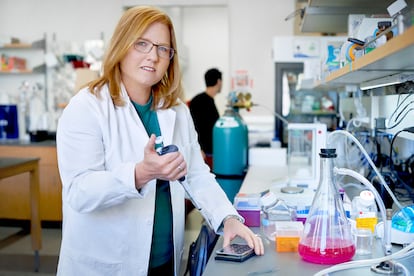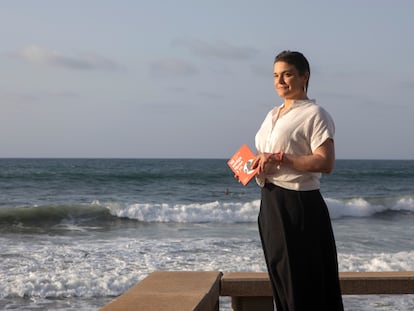The engineer who teaches our bodies to heal themselves
Kristi Anseth, winner of the L’Oréal-UNESCO for Women in Science Award, studies how biomaterials can counteract the debilitating effects of aging

The ancient Egyptians used sutures made of linen and animal sinew. In South Africa and India, the heads of large biting ants were used as clamps to hold the edges of wounds together. For centuries, humans have used natural and artificial materials to repair all kinds of tissues. More than 4,000 years later, American engineer Kristi Anseth is studying how newer, more sophisticated biomaterials assist in regenerating cartilage, help bones heal faster, and provide a better understanding of some diseases.
“Biomaterials can play a key role in helping our bodies heal themselves,” said Anseth, who received the 2020 L’Oréal-UNESCO For Women in Science international award in late June (after a two-year pandemic hiatus). In an interview with EL PAÍS conducted at the awards ceremony in Paris, the researcher who specializes in regenerative medicine and tissue engineering, and also designs synthetic materials that imitate our tissues, said, “We are using materials designed for textile products like mattresses or clothing, and making them interact with the human body.”
Biomaterials “can be used to deliver molecules that help [injured or diseased] tissues heal faster,” said Anseth, who is also an Associate Professor of Surgery at the University of Colorado in the United States. “When you only inject cells and nothing else, sometimes they don’t survive very well on their own. They need a three-dimensional environment – a biomaterial that can provide the scaffolding and instructions on where and when to grow the right kind of tissue.”
Many types of biomaterials are commonly used today – heart valves, hip joint replacements, and dental implants. They are made from cells, living tissues, metals, ceramics, plastics, and glass. The US National Institute of Biomedical Imaging and Bioengineering notes that biomaterials can be used in molded or machined parts, coatings, fibers, films, foams, and fabrics for biomedical products and devices. Anseth highlights the potential of degradable sutures that can “bind tissues together and dissolve once they have healed.”
Anseth explains how biomaterials are used to heal arthritis, an inflammation of the joints that can cause pain and swelling. What usually happens, says Anseth, is that the cartilage that lines a joint – like the knee – wears down. “When you don’t have that lubricating cartilage surface in between and bones are grinding against each other – it’s painful,” she said. “But we have a lot of extra cartilage in our body… so we can take it from somewhere else, grow the cells in a bioreactor, and insert them into the joint to grow and regenerate that cartilage surface.”
In addition, there are some proteins called growth factors, which “can also help tissues and cells grow and heal themselves.” Anseth says that these can be useful for fractured bones. “Although our bones can usually heal on their own, sometimes a cast or plates and screws are needed. It’s a long [healing] process,” she said, “and sometimes large defects caused by a car accident or bone cancer may not heal very well.”
Anseth said a growth factor found in bone marrow can be useful in these cases, but there’s a catch. “You can’t administer it on its own for a major bone injury because it could degrade.” That’s where biomaterials come in. They can be used “to deliver that [growth] factor locally for longer periods of time and at the right dose, time, and place.”
Risk of infection
Despite their great potential, biomaterials also have limitations. There is a risk of infection if they are not biocompatible. The presence of exogenous materials in the human body dates back to prehistoric times, as documented in a study published in Processes, a scientific journal. A spearhead embedded in the hip of Kennewick Man, a 9,000-year-old skeleton found in Washington state (US), and the use of carbon particles for tattooing are examples of foreign objects that were tolerated by human bodies centuries ago.
Two key factors determine the biocompatibility of a material, according to a study published in Materials: host reaction and degradation in the body. Sometimes, says Anseth, “it’s difficult to get biomaterials to degrade at the same rate as new tissue growth.” Moreover, getting a biomaterial to have all the desired properties “is tricky…. Bones, for example, are really strong and most biomaterials are not as strong or don’t have the same properties,” said Anseth.
More research is still needed to unravel all the mysteries of the human body. Anseth said: “We have regenerated skin, cartilage, and blood vessels, and we have also helped bones heal faster. But we still need to do more [research]. For example, why doesn’t the heart regenerate after a heart attack in the same manner as the skeletal muscles we use for walking and exercise?”
Anseth foresees “significant advances in medicine” over the next 10 years. “We’re going to figure out how we can intervene earlier to get muscles to grow, repair cartilage. or heal nerves… things that aren’t possible right now.” One of her most ambitious goals is to counteract age-related health problems. Age, a risk factor for multiple chronic diseases, is often accompanied by a loss of body mass.
As we age, “something happens to our cells,” said Anseth. “They have divided many times over a lifetime, and are no longer as active or able to repair themselves.” Biomaterials could provide young stem cells to help muscles grow back. “Aging is a complex natural process that we can’t necessarily reverse, but we can improve the quality of life for people experiencing degeneration in their joints, muscles and hearts.”
Tu suscripción se está usando en otro dispositivo
¿Quieres añadir otro usuario a tu suscripción?
Si continúas leyendo en este dispositivo, no se podrá leer en el otro.
FlechaTu suscripción se está usando en otro dispositivo y solo puedes acceder a EL PAÍS desde un dispositivo a la vez.
Si quieres compartir tu cuenta, cambia tu suscripción a la modalidad Premium, así podrás añadir otro usuario. Cada uno accederá con su propia cuenta de email, lo que os permitirá personalizar vuestra experiencia en EL PAÍS.
¿Tienes una suscripción de empresa? Accede aquí para contratar más cuentas.
En el caso de no saber quién está usando tu cuenta, te recomendamos cambiar tu contraseña aquí.
Si decides continuar compartiendo tu cuenta, este mensaje se mostrará en tu dispositivo y en el de la otra persona que está usando tu cuenta de forma indefinida, afectando a tu experiencia de lectura. Puedes consultar aquí los términos y condiciones de la suscripción digital.
More information
Últimas noticias
Most viewed
- Sinaloa Cartel war is taking its toll on Los Chapitos
- Reinhard Genzel, Nobel laureate in physics: ‘One-minute videos will never give you the truth’
- Oona Chaplin: ‘I told James Cameron that I was living in a treehouse and starting a permaculture project with a friend’
- Why the price of coffee has skyrocketed: from Brazilian plantations to specialty coffee houses
- David King, chemist: ‘There are scientists studying how to cool the planet; nobody should stop these experiments from happening’










































